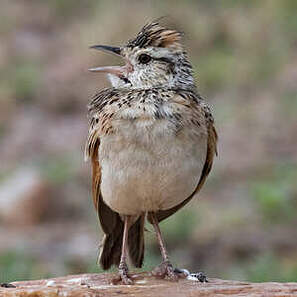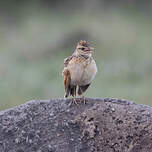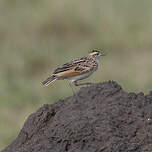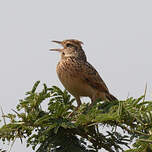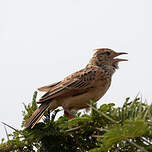Rufous-naped Lark
Corypha africana - Alouette à nuque rousse
Identification
The Rufous-naped Lark is a large, bulky looking lark, with wide wings and a relatively short tail. Its plumage, like most other larks, is cryptic, entirely in shades of cream, browns and tawny. And like other larks of the Mirafra genus, the primary remiges are largely chestnut-colored.
The head pattern is typical. The beak is long and strong, curved in appearance (this effect is due to the curved culmen and commissure) and bicolored, upper jaw generally chestnut brown and lower jaw rosaceous. Viewed from the front, the head appears clear and uniform. This aspect is due to the reddish-cream eyebrows, the lores of the same color, and finally the pale cheeks and ear coverts. This uniformity is accentuated by the white of the throat, but broken by the blackish streaks of the forehead. A short chestnut erectile crest crowns the top of the skull. The chestnut color of this crest, particularly visible when the excited bird exhibits it, especially when singing, can go completely unnoticed when it is flattened on the head, the chestnut then being masked by the black brown of the tip of the feathers forming a hardly streaked dark crown.
On the other hand, the nape is not chestnut as suggested by the bird's name.
The irises are brown, giving the eye a dark appearance.
The upper parts show a combination of browns, creams and chestnuts, with a striped appearance.
The chestnut of the remiges forms an already well visible wing panel on the closed wing. But when the Rufous-naped Lark opens its wings, for example during sequences of singing, the chestnut patches on the wing jump out.
The tail is dark-brown, with the outer rectrices bordered in chestnut.
The underparts are light. Viewed from the front, one can make out a pectoral band made of dark streaks of the same shade as the cap, against a light chestnut shaded background.The belly and flanks are cream to rusty brown in colour, the intensity of the red varying depending on the subspecies. The legs are pinkish or rosy.
Subspecific information 11 subspecies
- Corypha africana africana (se South Africa)
- Corypha africana tropicalis (e Uganda and w Kenya to nw Tanzania)
- Corypha africana ruwenzoria (e DRCongo to sw Uganda)
- Corypha africana chapini (se DRCongo and nw Zambia)
- Corypha africana occidentalis (w Angola)
- Corypha africana gomesi (e Angola and w Zambia)
- Corypha africana grisescens (w Zambia,n Botswana and nw Zimbabwe)
- Corypha africana pallida (sw Angola and nw Namibia)
- Corypha africana ghansiensis (e Namibia and w Botswana)
- Corypha africana isolata (se Malawi)
- Corypha africana transvaalensis (Tanzania to n South Africa)
Foreign names
- Alouette à nuque rousse,
- Alondra nuquirrufa,
- cotovia-de-nuca-vermelha,
- Kurzhaubenlerche,
- vörösnyakú bokorpacsirta,
- Roodnekleeuwerik,
- Allodola nucarossiccia,
- rödnackad lärka,
- Melankolilerke,
- škovránok hnedotylový,
- skřivan proměnlivý,
- Rødnakket Busklærke,
- punaniskakiuru,
- Rooineklewerik,
- alosa de clatell rogenc,
- skowroniec sawannowy,
- Африканский кустарниковый жаворонок,
- チャエリヤブヒバリ,
- 棕颈歌百灵,
- rödnackad lärka,
- 棕頸歌百靈,
Voice song and call
Mostly composed of three whistled notes repeated endlessly, the song of the male Rufous-naped Lark, emitted from a low support such as a termite mound, rock, or lying tree trunk is, especially during the rain season which coincides with the nesting period, a sound background that every bird enthusiast more or less consciously associates with wet savannas. At this time, it is common to hear several males singing from the same location.
The first note is slightly detached from the two following notes that follow in a slight descending pattern, often transcribed as tssiii-tsi'ou or siii-si'ou.
The male Rufous-naped Lark sings with his beak widely open and head slightly thrown back, crest raised. It is at this occasion that the identification of the Rufous-naped Lark is the easiest. It is not rare for the song to be accompanied, between two series of notes, with a vertical jump of a few centimeters, wings spread and vibrating, which resembles the characteristic behavior of other larks of the genus Mirafra, such as Mirafra rufocinnamomea for example.
Habitat
Behaviour character trait
The Rufous-naped Lark searches for food on the ground, scratching with its feet and beak to find insects and other invertebrates. Although it may seem bold when it sings, it can be less daring and even quite shy when disturbed. Instead of taking flight, the Rufous-naped Lark may flee on foot into the vegetation.
Flight
Dietfeeding habits
The Rufous-naped Lark feeds on arthropods, insects (grasshoppers, beetles, termites...), spiders, centipedes, as well as other invertebrates such as earthworms.
It also consumes seeds.
It looks for its food by scratching the ground with its feet, occasionally rummaging in the excrement of herbivores. It sometimes waits for termites that emerge from the termite mounds.
Reproduction nesting
The Rufous-naped Lark is monogamous. It reproduces during the wet season. As we mentioned above, the male is territorial and tirelessly delivers his three notes, sometimes jumping in place between strophes, with rapid wingbeats.
The nest is built in a shallow hollow scratched in the ground at the base of a tuft of grass or a small bush. This nest is made of grass and other vegetation elements, and intertwined in the vegetation that overhangs it to form a more or less complete dome roof. When the roof is complete, the entrance is on the side.The laying is 2-3 eggs, rarely 4, covered by the female. She flees when disturbed and does not return to her eggs until she hears a sound signal from the male. The incubation period is unknown.
The chicks are looked after by the female but fed by both parents. They leave the nest after 10 to 12 days, before being able to fly.
Geographic range
Threats - protection
IUCN conservation status
concern
in the Wild
threatened
evaluated
The Rufous-naped Lark is the most common African lark species and has the widest distribution area. Therefore, it is not globally threatened. However, populations may suffer from habitat loss due to cereal cultivation, although on the other hand they can benefit from farming, which tends to make the pastures more favourable to this species.
Sources of information
- IOC World Bird List (v14.2), Gill, F and D Donsker (Eds). 2024-04-18.
- Birds of East Africa: Kenya, Tanzania, Uganda, Rwanda, Burundi, Terry Stevenson, John Fanshawe
- Chamberlain's LBJs, Faansie Peacock
- HBW Alive,
- IUCN Red List of Threatened species,
Other sources of interest
 Specification sheet created on
30/07/2023 by Catherine et Bernard Lanneluc
Specification sheet created on
30/07/2023 by Catherine et Bernard LannelucTranslation by AI Oiseaux.net
© 1996-2025 Oiseaux.net
- Accipitriformes
- Aegotheliformes
- Anseriformes
- Apodiformes
- Apterygiformes
- Bucerotiformes
- Caprimulgiformes
- Cariamiformes
- Casuariiformes
- Charadriiformes
- Ciconiiformes
- Coliiformes
- Columbiformes
- Coraciiformes
- Cuculiformes
- Eurypygiformes
- Falconiformes
- Galliformes
- Gaviiformes
- Gruiformes
- Leptosomiformes
- Mesitornithiformes
- Musophagiformes
- Nyctibiiformes
- Opisthocomiformes
- Otidiformes
- Passeriformes
- Pelecaniformes
- Phaethontiformes
- Phoenicopteriformes
- Piciformes
- Podargiformes
- Podicipediformes
- Procellariiformes
- Psittaciformes
- Pterocliformes
- Rheiformes
- Sphenisciformes
- Steatornithiformes
- Strigiformes
- Struthioniformes
- Suliformes
- Tinamiformes
- Trogoniformes





